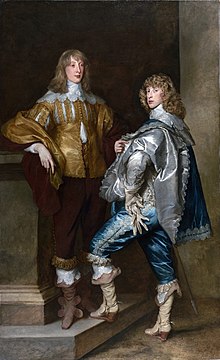
Back الحقبة الكارولينية Arabic Període de Carles I Catalan Oes Siarl Welsh Καρολίνεια εποχή Greek Era Charles ID Età di Carlo I Italian د کارولین دوره Pashto/Pushto Каролинская эпоха Russian Каролінська епоха Ukrainian
| Caroline era | |||
|---|---|---|---|
| 1625 – 1642 (1649) | |||
 | |||
| Monarch(s) | Charles I | ||
Chronology
| |||
| Periods in English history |
|---|
| Timeline |
The Caroline era is the period in English and Scottish history named for the 24-year reign of Charles I (1625–1649). The term is derived from Carolus, Latin for Charles.[1] The Caroline era followed the Jacobean era, the reign of Charles's father James I & VI (1603–1625), overlapped with the English Civil War (1642–1651), and was followed by the English Interregnum until The Restoration in 1660. It should not be confused with the Carolean era which refers to the reign of Charles I's son King Charles II.[2]
The Caroline era was dominated by growing religious, political, and social discord between the King and his supporters, termed the Royalist party, and the Parliamentarian opposition that evolved in response to particular aspects of Charles's rule. While the Thirty Years' War was raging in continental Europe, Britain had an uneasy peace, growing more restless as the civil conflict between the King and the supporters of Parliament worsened.
Despite the friction between King and Parliament dominating society, there were developments in the arts and sciences. The period also saw the colonisation of North America with the foundation of new colonies between 1629 and 1636 in Carolina, Maryland, Connecticut and Rhode Island. Development of colonies in Virginia, Massachusetts, and Newfoundland also continued. In Massachusetts, the Pequot War of 1637 was the first major armed conflict between the people of New England and the Pequot Tribe.
- ^ Hirsch, Edward (2014). A Poet's Glossary. p. 93. ISBN 9780547737461.
- ^ Oxford Reference retrieved 20 February 2020.
© MMXXIII Rich X Search. We shall prevail. All rights reserved. Rich X Search